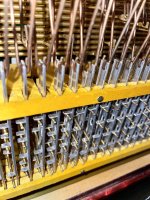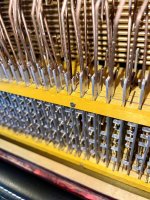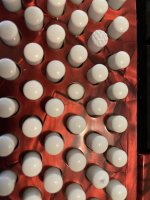forró
Member
I noticed the problem about a week ago. It only happens when the bellows are angled downwards (I do not mean straight 90° down)
It is only when I am standing this happens, because for whatever reason, my playing style tends to let the bellows droop more. It doesn't happen when I am sitting.
It is possible that the issue has always been there (it is over 40 years old) but I rarely play standing up and just didn't pick up on it.
Only one button is sticky and that is the B major button.
The tendency to stick is greater if the bellows are opened up more, and hence angled more downwards. I can unstick it by pressing the B minor button or some other note which is connected to the same linkage system.
I had a look inside and could not find any obvious reason for it sticking. I did have to place it on a chair, elevate it, and then release the bellow to see the mechanism as it would be under gravity.
I took it to a shop to have it looked at, and also to get a raised treble key sorted out.
The store owner said it needed some slight lubrication, and whatever he did seems to have fixed it...for a few days, but now it's happening again.
Any thoughts?
It is only when I am standing this happens, because for whatever reason, my playing style tends to let the bellows droop more. It doesn't happen when I am sitting.
It is possible that the issue has always been there (it is over 40 years old) but I rarely play standing up and just didn't pick up on it.
Only one button is sticky and that is the B major button.
The tendency to stick is greater if the bellows are opened up more, and hence angled more downwards. I can unstick it by pressing the B minor button or some other note which is connected to the same linkage system.
I had a look inside and could not find any obvious reason for it sticking. I did have to place it on a chair, elevate it, and then release the bellow to see the mechanism as it would be under gravity.
I took it to a shop to have it looked at, and also to get a raised treble key sorted out.
The store owner said it needed some slight lubrication, and whatever he did seems to have fixed it...for a few days, but now it's happening again.
Any thoughts?




